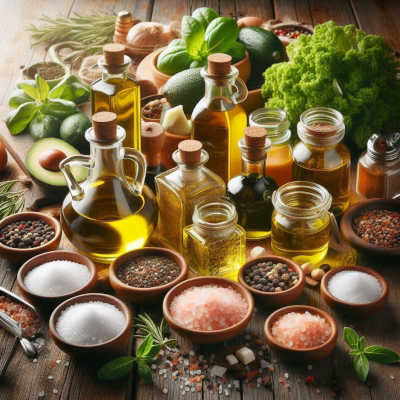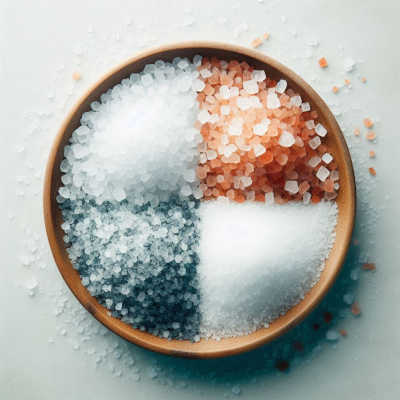
When cooking, we nearly always need to use oil and salt, but which type of oil or salt should we use in different recipes? I've tried to go through some of the commonly available oils and salts below.
Using oils and fats
When it comes to oil or hard fat, there's a huge range: Unrefined, refined, virgin, extra virgin and solid block. We're using these oils or fats for a mix of flavour, mouth feel and to prevent sticking when frying. Below we'll discuss the common ones.
Refined vs unrefined oils
A refined oil is one where impurities in the oil are removed, increasing its smoke point and neutralising flavour (I.E. deodorize the oil). Whereas an unrefined oil is minimally processed, and usual from the first pressing, but because of this unrefined oil has a lower smoke point.
Unrefined oils (E.G. Olive oil)
Uses: Dressings, baking, saute frying only.
Olive oil is probably the one oil where the supermarkets carry an extremely wide range, from refined cooking oil right through to unrefined extra virgin oil, in other words, the first cold pressing of the olives.
You can also get other oils unrefined. For example, I purchase unrefined sunflower oil, which has a completely different look and taste to regular refined sunflower oil.
In summary, I often use unrefined oil in baking and even sometimes use it for sauté frying. It will impart its own flavour as it will not be deodorised. The smoke point is lower, so I would avoid high-temperature frying with any unrefined oil.
Refined Vegetable, seed, sunflower oils
Uses: Baking, frying, high-temperature cooking.
Refined oils are the general purpose oils you see in most supermarkets, they are generally very light in colour as they are refined and deodorised. These have a higher smoke point and can be used for high-temperature frying. Unfortunately, the cheaper of these are generally refined using harsh chemicals. As I understand it, organic oils are often refined using more gentle methods, and you can purchase "organic frying oil".
You can use these oils for pretty much any purpose, they are pretty much flavourless, so I guess safer in recipes that are sensitive to changes in flavour.
Butter and lard - solid fats
Butter is formed from milk, it is around 70 to 80 percent fat, and you can interchange it with oil in many recipes. It has a pleasant savoury taste that works well, especially during the cooking of cream based soups and meats.
Butter comes both salted and unsalted, and personally I tend to always use salted. I guess in cake-making and other sweet recipes unsalted butter may work better.
Butter has a low smoke point, don't use for high-temperature cooking. However, you can use ghee, which is effectively refined/clarified butter; making it safe for high-temperature cooking.
Lard is the rendered fat of the pig, which when cooled, sets as it is a saturated fat. It has less flavour than butter but can be used for high-temperature frying. Similar to lard, goose fat and beef dripping are also block fats.
It goes without saying that lard, beef dripping, or goose fat can't be used in a vegetarian recipe, and butter can't be used in a vegan recipe.
Using Salt
Salt is often given a bad rap because of its correlation with blood pressure. Although we should limit the amount we eat, we cannot live without salt, and without it food would taste bland. There are a few different types of salt, and here I'll cover the differences in flavour amounts needed.
Importantly, it is better to weigh out salt, as depending on the fineness or coarseness of the salt a teaspoon of it will weigh out differently. The image below exaggerates the differences in coarseness; but I'm sure that you can imagine a teaspoon of each will provide varying amounts of salt.

Sea salts
This type of salt is evaporated from sea water. There are many different brands of sea salt with different method of how the salt is extracted. It is usually lightly refined and many trace minerals remain, these affect the flavour meaning you may be able to use less sea salt for the same taste.
Rock salts
Rock salt is a natural form of sodium chloride that is mined from underground. There are several different types and colours. Food safe forms of rock salt include Pink Himalayan salt and white rock salt. Again, like sea salt it is usually lightly refined and many trace minerals remain.
Fine table salt
Table salt is generally a rock salt processed to remove impurities and other minerals, resulting in a fine, white powder. Generally, weights of salt in recipes are probably based on table salt.
These may be of interest
- Similar - Make your own italian herb mix from scratch
- Similar - Making bread using yeast
- Similar - Tools needed for bread making
- Similar - A few notes for those getting started breadmaking
- Similar - March - preparing seeds for growing
